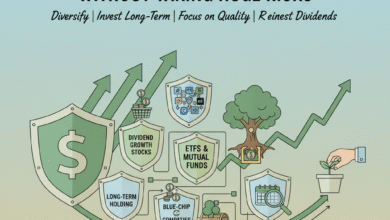How to Maximize Returns and Minimize Risk When Investing in Stocks

Investing in the stock market can feel overwhelming, especially when headlines scream about market volatility and economic uncertainty. But here’s the truth: minimizing risk when investing in stocks isn’t about avoiding the market entirely—it’s about making smart, informed decisions that protect your capital while positioning you for long-term growth.
Whether you’re looking for winning stocks or trying to identify the best stocks to buy, understanding risk management is the foundation of successful investing. This comprehensive guide walks you through proven strategies to reduce exposure to losses and build a portfolio that works for your financial goals.
Understanding Investment Risk: What You Really Need to Know
Before we dive into strategies, let’s clarify what risk actually means in the stock market context. Investment risk isn’t just about losing money—it’s about volatility, market fluctuations, and the gap between expected and actual returns.
Types of stock market risk include:
- Market Risk: Overall market downturns affecting all stocks
- Company-Specific Risk: Individual company performance issues
- Liquidity Risk: Difficulty selling shares quickly at fair prices
- Inflation Risk: Returns not keeping pace with rising costs
- Interest Rate Risk: Market sensitivity to economic policy changes
The key insight? Not all risk is equal. Some risks are avoidable, while others are inherent to investing. The art of managing your portfolio is learning to minimize the controllable risks while accepting that some volatility is simply part of the game.
Strategy #1: Diversification—Your First Line of Defense
Diversification is the closest thing we have to a free lunch in investing. When you diversify your holdings, you spread risk across multiple securities, sectors, and asset classes rather than putting all your eggs in one basket.
How to Diversify Effectively
| Diversification Level | Strategy | Risk Reduction |
|---|---|---|
| Sector Diversification | Hold stocks across tech, healthcare, finance, energy, consumer goods | Reduces company-specific risk |
| Geographic Diversification | Include domestic and international stocks | Reduces country-specific risk |
| Market Cap Diversification | Mix large-cap, mid-cap, and small-cap stocks | Balances growth and stability |
| Asset Class Diversification | Combine stocks, bonds, and alternative investments | Reduces portfolio volatility |
Action step: Aim for at least 15-20 different holdings across different sectors. If individual stock picking feels daunting, consider broad market index funds that automatically diversify for you.
Strategy #2: Dollar-Cost Averaging—Steady Wins the Race
One of the most effective ways to minimize risk when investing in stocks is to avoid trying to time the market perfectly. Dollar-cost averaging (DCA) involves investing a fixed amount regularly, regardless of market conditions.
Why DCA works:
- Removes emotional decision-making from the equation
- Reduces the impact of buying at market peaks by averaging prices over time
- Builds discipline into your investing routine
- Lowers average cost per share in a declining market
For example, investing $500 monthly for five years means you’ll buy more shares when prices are low and fewer when they’re high—naturally optimizing your entry points without requiring market-timing superpowers.
Real-world example: An investor who contributed $500/month to the S&P 500 from 2020-2024 weathered the pandemic downturn, inflation surge, and rate hikes with significantly better results than someone who invested a lump sum at the market’s peak in 2021.
Strategy #3: Focus on Quality When Hunting for Winning Stocks
Not all stocks are created equal. When searching for winning stocks and the best stocks to buy, quality should be your north star. Quality-focused investing means prioritizing financially stable companies with strong fundamentals.
Key Metrics for Identifying Quality Stocks
Profitability Indicators:
- Profit margin above industry average
- Consistent earnings growth year-over-year
- Strong return on equity (ROE) of 15%+
Financial Health:
- Debt-to-equity ratio below 1.0
- Strong cash reserves and positive cash flow
- Credit ratings from reputable agencies
Competitive Advantages:
- Recognizable brand or market dominance
- Innovative products or services
- Sustainable competitive moats
Companies with these characteristics tend to weather market storms better than high-volatility stocks. They may not double overnight, but they’re more likely to deliver stable, long-term returns.
Strategy #4: Set Clear Stop-Loss Limits
One psychological trap that trips up many investors is hoping that a losing position will bounce back. Setting predetermined stop-loss limits helps you minimize risk when investing in stocks by forcing disciplined decision-making.
A stop-loss is a predetermined price at which you’ll sell a stock to limit further losses. For example:
- Buy stock ABC at $50
- Set stop-loss at $42.50 (15% below purchase price)
- If ABC drops to $42.50, it sells automatically
This isn’t about pessimism—it’s about protecting capital and freeing up money for better opportunities.
Pro tip: Adjust stop-loss levels as stocks appreciate. If ABC rises to $60, move your stop-loss to $54, locking in some gains while maintaining upside potential.
Strategy #5: Understand Your Risk Tolerance and Investment Timeline
Risk tolerance varies from investor to investor. Your age, financial obligations, and investment goals all play a role in determining how much volatility you can comfortably handle.
Risk Tolerance Assessment
| Profile | Age Range | Typical Allocation | Best Approach |
|---|---|---|---|
| Aggressive | Under 35 | 80-100% stocks | Growth-focused; weather downturns |
| Moderate | 35-55 | 60-70% stocks | Balanced growth and stability |
| Conservative | 55+ | 40-60% stocks | Income-focused; capital preservation |
Your timeline matters enormously. A 25-year-old investor minimizes risk by staying invested through market cycles, not by fleeing to cash. Conversely, someone within five years of retirement needs a different approach to minimize risk when investing in stocks.
Strategy #6: Research Before You Buy—Due Diligence Pays
Finding the best stocks to buy requires homework. Before investing a single dollar, review:
- Financial statements: Annual reports (10-K filings)
- Analyst reports: Multiple perspectives on valuation
- Industry trends: Is the sector growing or contracting?
- Management quality: Track record of the leadership team
- Competitive landscape: How does this company stack up?
Credible research sources:
- SEC filings (sec.gov)
- Company investor relations pages
- Reputable financial publications (WSJ, Reuters, Bloomberg)
- Independent analyst platforms
- Earnings call transcripts
Spend 30 minutes researching a $5,000 investment. The insights gained far outweigh the time investment.
Strategy #7: Rebalance Regularly
Market movements naturally shift your portfolio’s balance. A stock that doubles becomes 20% of your portfolio (instead of 10%), increasing concentration risk. Regular rebalancing helps minimize risk when investing in stocks by maintaining your intended allocation.
Rebalancing best practices:
- Review quarterly or semi-annually
- Rebalance when allocations drift 5% or more from targets
- Use new contributions to buy underweight positions
- Harvest tax losses while rebalancing (if in taxable accounts)
Strategy #8: Leverage Winning Stocks Through Sector Exposure
Rather than trying to pick individual winning stocks, consider sector ETFs or mutual funds that provide exposure to industries with strong growth potential. This approach offers:
- Professional management and research
- Built-in diversification within sectors
- Lower fees than active stock picking
- Reduced single-company risk
Key Takeaways: Your Action Plan
To effectively minimize risk when investing in stocks:
- Diversify across 15+ holdings in different sectors and geographies
- Implement dollar-cost averaging through regular monthly investments
- Focus on quality fundamentals when selecting winning stocks
- Set stop-loss limits to protect capital
- Align your portfolio with your risk tolerance and timeline
- Research thoroughly before committing capital
- Rebalance quarterly to maintain intended allocations
- Stay informed about economic trends and market conditions
The Bottom Line
Minimizing risk when investing in stocks doesn’t require complicated strategies or perfect market timing. It requires discipline, diversification, and a commitment to your long-term plan. The best stocks to buy are those that fit your overall strategy and risk profile—not necessarily the ones making headlines.
Remember: the goal isn’t to eliminate risk entirely (that would mean no investing at all). Instead, focus on managing risk intelligently so you can sleep soundly while your portfolio grows steadily toward your financial goals.
Ready to refine your investment strategy? Start by assessing your risk tolerance, identifying your investment timeline, and building a diversified portfolio aligned with your objectives. Your future self will thank you for taking these steps today.
READ MORE : Best Stock Trading Strategies for Consistent Income and Long-Term Success
READ MORE : Top 5 Proven Affiliate Marketing Strategies to Earn Passive Income in 2025


